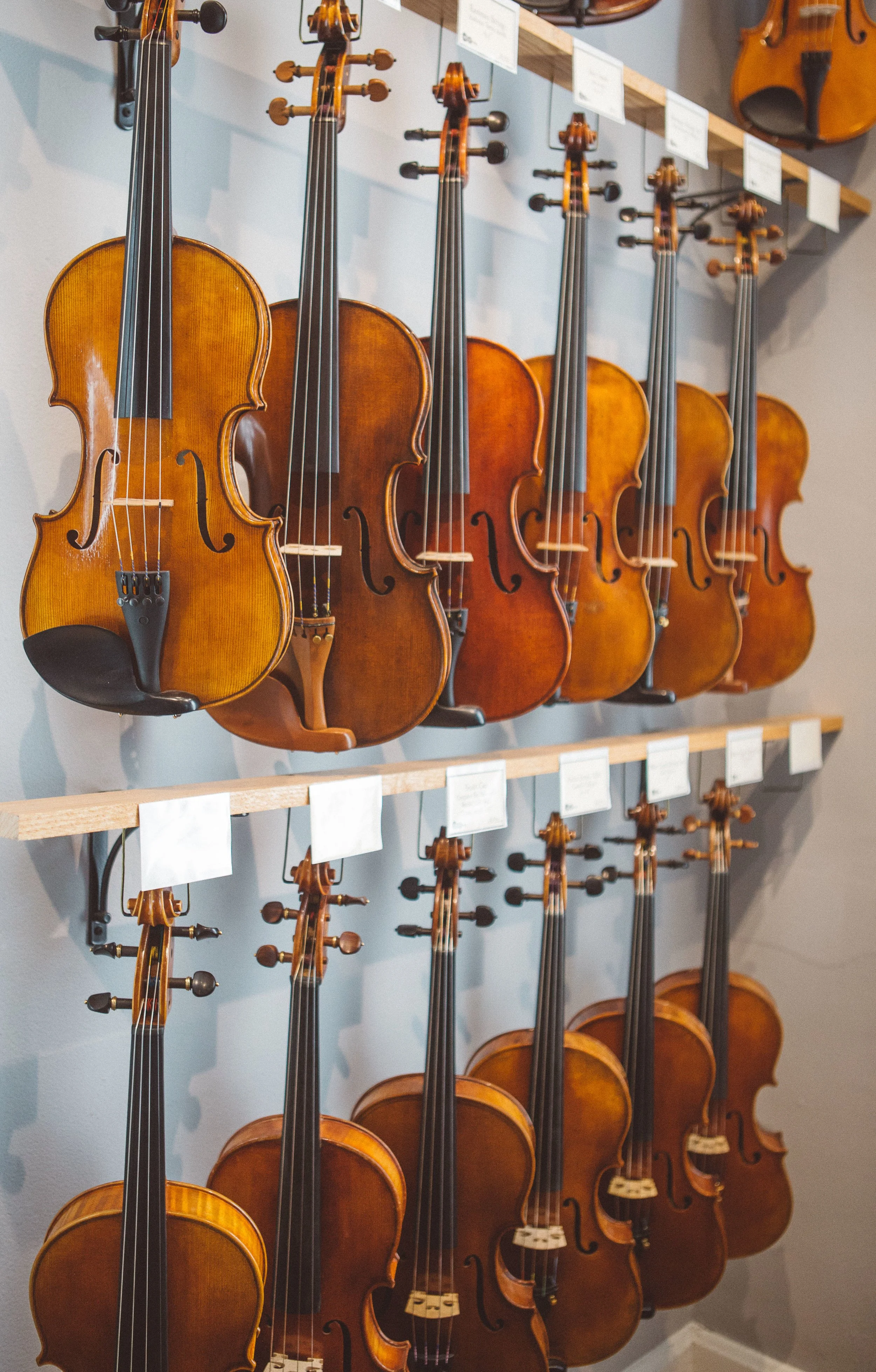HOW TO CHOOSE GUT STRINGS
Before choosing one gut string over another, there are a few things to consider: gut strings break and go out of tune quite easily because it is an organic material that wears out with use, sweat and friction. Therefore, the points that suffer the most are those through which the bow passes and those where we place our fingers. Specifically, the E string, being the thinnest, is the first to break (if you practise a lot, it usually takes about a month).
On the other hand, when we put the string on the violin, it is very likely that it will take a few days to stabilise (when they are new, they go out of tune easily). It is best to put the string on the day before you use it and leave it tuned almost half a tone higher, because what will happen is that the tuning will go down by itself in that period of time. Therefore, if you are planning a concert, I recommend that you prepare the strings as described in the following section, so that if a string breaks, you will lose as little time as possible.
Preparing the strings
The gut strings III, II and I sold in specialist shops are usually twice the length required for playing the violin and therefore need to be cut in half. Nevertheless, my recommendations for preparing the strings are as follows:
➤ Wash your hands before handling the strings.
➤ Soak them in olive oil for an hour.
➤ Dry them with absorbent paper. This will ensure that the strings are better hydrated and less likely to break.
➤ Cut the rope you want to use in half.
➤ Make a double knot at one end.
➤ Place the rope on the cordal.
➤ Insert the unknotted end into the appropriate peg.
➤ It is important to remember that the heat and friction of your fingers will cause the gut to expand. Therefore, to tune the gut string, first tension it above its exact tuning point and then release it to the desired setting. When the tuning peg is moved, the string will usually make a noise, but this is perfectly normal.
➤ When tuning, it is advisable to stretch the string with your fingers along its entire length, as if you were massaging it, stretching it from the neck to the bridge. You can also warm it up by running your hand over it to lower the pitch and then raise it with the peg.
➤ Strum the string with the bow and leave the string impregnated with resin. This makes the string less likely to slip. In this way, unlike metal strings, there is no need to clean the area of friction with the bow after playing.
➤ Finally, it is important to position the peg correctly so that the tuning movements are comfortable. Moreover, if the peg is not properly aligned when the string is fitted, the end of the peg inserted into the peg should be pulled slightly until the orientation of the peg is readjusted.
My recommendations for gut string gauge are as follows:
➤ Pirastro Oliv G string: silver braided gut (the G string is the only braided string, the rest is natural gut).
Estimated price: 60 Euros.
➤ Pirastro Eudoxa G string.
Estimated price: 25 Euros // 25 Euros.
➤ D string (gauge: 112 hundredths of a millimetre).
Estimated price: 12 Euros.
➤ A string (gauge: 74 hundredths of a millimetre).
Estimated price: 10 Euros.
➤ E string (gauge: 64 hundredths of a millimetre).
Estimated price: 8 Euros.
Gut strings that are more than gut
While traditional gut strings are made solely from the intestines of sheep or cows, there are some newer gut string brands that incorporate other materials into their strings. Here are a few examples:
➤ Passione: Passione strings are made by Pirastro and combine gut with other materials like steel, silk and silver. They are designed to produce a warm and rich sound.
➤ Chorda: Chorda strings are also made by Pirastro and are made using a unique production process that results in a very authentic gut string sound. However, they may not be as durable as other gut string brands.
➤ Gut-A-Like: Gut-a-like strings are a synthetic gut string that are designed to mimic the sound and feel of traditional gut strings. They are a popular option for musicians who want the sound of gut strings without the fragility. Overall, there are many options when it comes to gut strings, and it’s important to consider your playing style, instrument and budget when choosing the right brand. Dominant strings are a popular and reliable option, but it may be worth exploring some of the newer gut string brands that incorporate other materials.
Installing and maintaining violin strings
➤ Strings should be replaced at least once every six months.
➤ Strings should also be replaced if they become worn, damaged or lose their tone quality.
➤ If you play your violin regularly, you may need to change your strings more frequently.
➤ String tension can affect the sound quality of your instrument.
➤ A higher tension string will produce a brighter and more powerful sound, while a lower tension string will produce a darker and softer sound.
➤ It is important to find the balance between tension and sound quality that suits your personal preferences.
➤ It is also important to make small adjustments to the tuning and tension of your strings as needed, particularly in response to atmospheric changes or as your instrument adjusts to a new set of strings.
In sum, maintaining your violin strings is an important part of ensuring that your instrument produces the desired sound quality. Regularly replacing worn or damaged strings, following proper installation techniques and making adjustments to string tension can contribute to a better overall playing experience. By taking care of your violin strings, you can continue to play beautiful music for years to come.
Frequently Asked Questions
-
There are various types of violin strings, including gut strings, steel core strings and synthetic core strings. Gut strings are made from sheep intestine; steel core strings consist of a solid or stranded steel core; and synthetic core strings are made with a synthetic material, often having characteristics similar to gut strings.
-
When choosing violin strings, consider factors like your playing style, desired sound and budget. Understand the unique qualities offered by gut, steel and synthetic core strings. Experimenting with different string sets and gauging the results can help you find the best violin strings for your instrument.
-
Gut strings are made from sheep intestine, offering a warm and rich sound. However, they are more sensitive to changes in temperature and humidity, requiring regular tuning. Synthetic core strings provide similar tonal qualities to gut strings, but they are more stable and have a longer lifespan. They can be a great option for those seeking both qualities of gut and synthetic materials.
-
Steel core strings have a bright and powerful sound, making them ideal for a more focused projection. They are also more resistant to climate changes and last longer than gut strings. Many professional violinists prefer steel strings for their durability and consistency.
-
String gauge and tension play a significant role in the sound and playability of a violin. Thinner strings produce a brighter sound and require less tension, making them easier to play. However, they can break more easily. Thicker strings generate a warmer, more powerful sound but require more tension and effort to play. Experimenting with different gauges and tensions can help you achieve your desired sound and feel.
-
Typically, violinists should change their strings every 3-6 months, depending on their playing frequency and the type of strings used. Gut strings may require more frequent changes due to their sensitivity, while steel or synthetic core strings may last longer. Signs that you need to change your strings include loss of sound quality, difficulty tuning, or visible signs of wear and tear.
-
For beginners, it’s crucial to choose violin strings that offer balance in sound, durability and price. Synthetic core strings can be a great choice for starters due to their sound qualities and stability. As your skills advance, experimenting with different types of strings can help you find the right fit for your playing style and preferences.
-
The best violin strings for your instrument may vary depending on your playing style, violin quality and preferred sound. Generally, gut strings are recommended for advanced players due to their rich sound and increased maintenance. Synthetic core strings are suitable for various skill levels and provide a warm, stable tone. Steel core strings are preferred for a brighter sound and durability. Experimenting with different brands and types can help you find the perfect match for your violin.
-
You can buy violin strings from music stores or online retailers. When purchasing, consider factors like your playing preferences, desired sound quality and budget. Compare brands and read reviews from other musicians to find the best strings for your instrument.
-
Some popular violin string brands include Pietro Toro,Pirastro, Aquila, Kürschner, Pyramid and Savarez. Each brand offers a range of different types of strings suitable for various skill levels and preferences. Exploring these brands and trying their various offerings can help you find the best violin strings for your instrument.
Read more articles
Quick video tips
““It is important to remember that the heat and friction of the fingers cause the stomach to expand.””





















